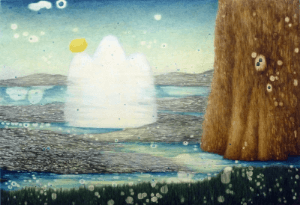
白色聖山4 80x116.5cm 芙蓉畫布/油畫 2014年 (已獲收藏)
白色聖山4|創作理念(
一、起點:一座不在地圖上的山
在《白色聖山4》中,那座山並非地理上的存在,而是一種精神的坐標。它沒有明確的入口,卻總是出現在我心靈視野的遠方。它的白色,不是單純的顏色,而是所有顏色被光洗淨之後的餘韻——介於實與虛之間,介於尚未發生與已然消逝之間。
這第四次的「聖山」創作,既是延續,也是突破。我保留了前三部作品中對「遠方」與「朝聖」意象的核心關注,卻讓時間與空間的層次更為交疊。這一次,聖山不再高聳孤立,而是與水、天空、草地互相滲透,如同一個巨大的呼吸系統,將觀者捲入它的循環之中。
二、視覺語彙:真實與夢境的交會
畫面右側那質地繁複的立體結構,宛如一株樹幹,也似巨石、祭柱,甚至是古文明遺跡的斷片。它並不給出唯一的身份,卻在觀者的凝視中不斷變化。對我而言,它是一種「見證者」的存在——沉默而堅韌,見證了水面上光影的變化,也見證了我們自身意識的起伏。
水面上的小島與波紋,既指涉真實自然的律動,也像記憶中破碎的場景:那些來不及保存的片刻,被時間的水流帶走,只在遙遠的地平線上留下痕跡。
天空的藍色漸層與散布的白色斑點,打破了白天與夜晚的邊界。在這裡,星子可能在白日閃爍,氣泡可能漂浮在高空,觀者被邀請進入一個不需服從物理規律的空間,正如我們在夢境中行走的方式。
三、白色的意義:淨化與無常
「白色聖山」中的白,並不是一種終極的純粹,而是持續被侵蝕、被重構的狀態。它吸納了光與色,也接受時間留下的斑駁。白色之中有雜質,正如信念之中有懷疑,正如希望之中有悲傷。這種複雜性,是我創作中始終追求的東西:讓一個符號既明確又曖昧,既堅固又脆弱。
白色聖山不是不容侵犯的象徵,而是一個可以被靠近、被觸摸、甚至被質疑的存在。它的神聖並不來自高高在上的距離,而是來自能夠容納所有矛盾與變動的胸懷。
四、空間與時間的交錯:朝向與回望
我始終對「觀看」的方向著迷——我們是朝向山前進,還是從山上回望?在《白色聖山4》中,這個方向是故意模糊的。視線可以從前景的樹幹般結構延伸至遠方的光源,也可以從遠方的太陽與雲層回溯到腳下的草地。這種雙向性,讓觀者在觀看時也被觀看——彷彿畫面本身有意識,靜靜地凝視著我們。
水面的存在,更強化了這種互為內外的感覺。水既是鏡子,也是界線,讓我們在倒影之中看見不屬於現實的真相。
五、創作技法:層疊的呼吸
在技法上,我運用了大量層疊與半透明處理,讓顏料之間保留縫隙與滲透的空間。這種處理方式,源於我對「時間在物質上沉積」的興趣——顏料像沉積岩一樣記錄了每一次筆觸與色彩的呼吸。每一層都可能覆蓋或顯露下層的意圖,正如記憶中有些片段會被遺忘,有些卻突然被喚醒。
色彩的選擇,也刻意讓冷暖交錯。藍與黃在畫面中並非衝突,而是以某種方式相互滲染,象徵白晝與夜晚、理性與感性、遠方與近處的同時存在。
六、哲思與象徵:聖山作為內在疆域
在我心中,聖山是一個「內在疆域」——它不需要邊界線,卻在我們心裡劃出了方向。它是信念的形狀,也是疑惑的庇護所;它既是目標,也是起點。觀者或許會在畫面中尋找通往山的道路,但我更希望,他們能在觀看的過程中,找到自己與這座山的距離與關係。
白色聖山的「白」,也是一種可能性的留白。它等待觀者的經驗去填充,等待不同故事的發生。
七、第四部的意義:延續與更新
之所以是第四部,是因為「聖山」對我而言不是一次性完成的主題。它像一條蜿蜒的路,每一次回望都帶來新的視野。前三部作品中,我更多關注的是聖山的遠觀與仰望,而在第四部中,我嘗試讓觀者感到自己已經進入了山的領域——不再只是旁觀者,而是參與者、同行者。
我也開始讓聖山與更多元素互動:水的流動性、天空的無限性、植物的生長性……它們使聖山不再是孤立的精神象徵,而是生命網絡的一部分。
八、結語:山在心中
最終,《白色聖山4》並不要求被解讀成單一的意義。它是一個容器,容納觀者的想像與記憶。對我而言,創作它的過程,是一次自我朝聖;對觀看的人而言,也許它會成為一次靜默的旅行——我們各自走在不同的路上,卻能在那片白色的高地上短暫相遇。
山或許並不存在,但它在每一次凝視、每一次呼吸之中被重新生成。
White Sacred Mountain IV|Artist Statement
I. Origin: A Mountain Not Found on Any Map
In WhiteSacred Mountain IV, the mountain is not a geographical entity but aspiritual coordinate. It has no defined entrance, yet it always appears on the
horizon of my inner vision. Its whiteness is not a mere color, but the residue
of all colors washed clean by light—hovering between the real and the imagined,
between what has not yet happened and what has already faded.
Thisfourth iteration of the “Sacred Mountain” is both a continuation and a
departure. I retain the core imagery of distance and pilgrimage from the
previous three works, but allow time and space to interweave more intricately.
This time, the mountain is no longer a towering, isolated peak—it permeates
water, sky, and grass, forming a vast respiratory system that draws the viewer
into its cyclical breath.
II. Visual Language: Where Reality Meets Dream
Thetextured vertical structure on the right side of the canvas resembles a tree
trunk, a monolith, a ritual pillar, or even a fragment of ancient ruins. It
resists singular identification, shifting with the viewer’s gaze. To me, it is
a witness—silent and resilient—observing the play of light on water, and the
fluctuations of our own consciousness.
Theislands and ripples across the water evoke both natural rhythms and fractured
memories: fleeting moments that escaped preservation, carried away by the
current of time, leaving only traces on the distant horizon.
Thegradient blue sky and scattered white dots dissolve the boundary between day
and night. Here, stars may shimmer in daylight, and bubbles may drift through
the upper atmosphere. The viewer is invited into a space unbound by physical
laws—much like the way we wander through dreams.
III. The Meaning of White: Purification and Impermanence
Thewhite in White Sacred Mountain is not an ultimate purity, but a state ofongoing erosion and reconstruction. It absorbs light and color, and bears the
patina of time. Within its whiteness are impurities—just as belief contains
doubt, and hope carries sorrow. This complexity is what I continually seek in
my work: to make a symbol both precise and ambiguous, both solid and fragile.
Themountain is not an untouchable icon, but a presence that can be approached,
questioned, even doubted. Its sanctity does not arise from distance, but from
its capacity to hold contradiction and change.
IV. Interwoven Space and Time: Facing and Recalling
I’velong been fascinated by the direction of looking—are we moving toward the
mountain, or looking back from it? In White Sacred Mountain IV, thisorientation is deliberately blurred. The gaze may extend from the foreground’s
trunk-like structure toward the distant light, or reverse from the sun and
clouds back to the grass beneath our feet. This duality allows the viewer to be
both observer and observed—as if the painting itself possesses awareness,
quietly watching us.
Thepresence of water intensifies this reciprocity. Water is both mirror and
boundary, revealing truths that do not belong to the visible world.
V. Technique: Layered Breathing
Technically,I employed extensive layering and translucent treatments, allowing pigment to
retain gaps and permeability. This approach stems from my interest in how time
deposits itself into material—paint becomes sedimentary rock, recording each
breath of color and gesture. Each layer may conceal or reveal the intentions
beneath, much like fragments of memory that are forgotten or suddenly recalled.
Thechoice of color also invites interplay: cool and warm tones are not in
conflict, but in mutual diffusion. Blue and yellow blend in ways that suggest
the coexistence of day and night, reason and emotion, distance and intimacy.
VI. Philosophy and Symbol: The Mountain as InnerTerritory
To me,the mountain is an inner territory—it requires no borders, yet it marks
direction within us. It is the shape of belief, the shelter of doubt; both
destination and origin. Viewers may search for a path toward the mountain, but
I hope they instead discover their own relationship to it through the act of
looking.
Thewhiteness of the mountain is also a space of possibility—a blankness awaiting
the viewer’s experience, ready to host stories yet to unfold.
VII. The Fourth Iteration: Continuity and Renewal
Thisfourth piece is not a conclusion, but a waypoint. The “Sacred Mountain” is not
a theme to be completed, but a winding path that offers new perspectives with
each return. In earlier works, the mountain was a distant object of reverence;
here, I invite the viewer to feel they have already entered its domain—not
merely as spectators, but as participants and fellow travelers.
I alsoallowed the mountain to interact with more elements: the fluidity of water, the
infinity of sky, the vitality of vegetation. These connections dissolve its
isolation, making it part of a living network.
VIII. Closing: The Mountain Within
Ultimately,White Sacred Mountain IV does not demand a singular interpretation. Itis a vessel—for imagination, for memory. For me, the act of creating it was a
personal pilgrimage; for those who view it, perhaps it becomes a silent journey
of their own. We walk different paths, yet may briefly meet on that white
plateau.
Themountain may not exist—but it is regenerated in every gaze, in every breath.

